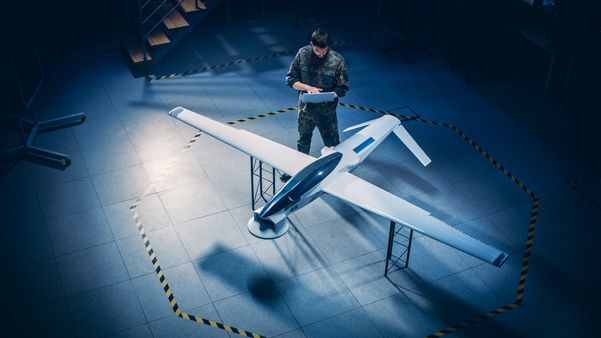Textron Inc. (TXT 0.73%) announced mixed third-quarter 2017 results on Thursday morning, highlighting solid top-line performances from Bell Helicopter and the Textron Systems division. But that growth was once again partially offset by a decline from Textron Aviation. With profitability headwinds from its industrial business, Textron followed by modestly reducing its earnings outlook for the full year.
After falling as much as 4.6% early in the day, Textron stock ultimately settled to close down around 0.9%. Let's take a closer look, then, at how the leading industrial conglomerate kicked off the second half of the year, as well as what investors can expect going forward.

IMAGE SOURCE: TEXTRON/BELL HELICOPTER.
Textron's results: The raw numbers
| Metric |
Q3 2017 |
Q3 2016 |
Year-Over-Year Change |
|---|---|---|---|
|
Revenue |
$3.484 billion |
$3.251 billion |
7.2% |
|
GAAP net income |
$159 million |
$421 million |
(62.2%) |
|
GAAP earnings per share |
$0.60 |
$1.55 |
(61.3%) |
Data source: Textron Inc.
What happened with Textron this quarter?
- On an adjusted (non-GAAP) basis -- which excludes restructuring expenses and a $0.76-per-share income tax settlement in last year's third quarter -- income from continuing operations was $0.65 per share, up from $0.61 per share in the same year-ago period.
- Textron Aviation revenue fell 3.7% year over year to $1.154 billion, driven by the delivery of 41 new Citation jets (flat from last year), 24 King Air turboprops (down from 29 last year), and five Beechcraft T-6 trainers (down from eight last year). On the bottom line, Aviation segment profit slumped 7% to $93 million, due to lower volume and unfavorable product mix. Textron Aviation's backlog climbed $142 million sequentially from last quarter to $1.2 billion.
- Bell revenue climbed 10.6% year over year to $812 million, including delivery of 39 commercial helicopters (up from 25 last year), eight H-1s (flat from last year), and five V-22s (down from six last year). Bell segment profit rose 9.3% to $106 million, and its backlog fell $413 million sequentially to $5.0 billion.
- Textron Systems revenue grew 10.9% year over year to $458 million, as higher volume in the Marine and Land Systems product line was partially offset by lower volume from Weapons and Sensors. Textron Systems profit fell 9.1% to $40 million.
- Industrial revenue increased 17.6% to $1.042 billion, driven primarily by Textron's acquisition of Arctic Cat earlier this year. Industrial segment profit declined 25.8% to $49 million, due to unfavorable volume, product mix, pricing, and inflation.
- Finance segment revenue dropped 10% year over year to $18 million, and finance profit rose roughly $4 million year over year, to $7 million.
- Cash flow from continuing operations of the manufacturing group was $100 million, down from $178 million in the same year-ago period. Manufacturing cash flow before pension contributions was $279 million, up from $94 million a year ago.
- Repurchased 2.5 million shares for $122 million.
What management had to say
"Growth in the third quarter was the result of strong commercial demand at Bell, increased deliveries at Textron Systems and higher revenues at Industrial due to the acquisition of Arctic Cat," Textron chairman and CEO Scott Donnelly added in a prepared statement.
During the subsequent conference call, Donnelly lauded continued strong execution at Bell, with its healthy 13.1% operating margin driven by strength in commercial helicopter deliveries. But he also noted that the industrial segment "had a fairly tough quarter," in particular with the vehicle business.
Donnelly elaborated:
The Artic Cat work is going well, but we have thrown a lot of resources -- particularly people -- at making sure that integration goes well. And frankly, we got a little behind on some of the rest of the business in terms of line rates and production output. As we worked our way through the quarter as we go here, and in the beginning of the fourth quarter, it looks like most of the line rates are back up to where we need them to be. We're not likely to be able to catch up on some of the miss from Q3.
Looking forward
Textron now expects full-year 2017 GAAP earnings per share from continuing operations to be in the range of $2.20 to $2.30 (down from previous guidance for $2.22 to $2.45) and adjusted earnings per share in the range of $2.40 to $2.50 (compared to $2.40 to $2.60 previously). On a more encouraging note, Textron simultaneously raised its guidance for full-year manufacturing cash flow from continuing operations (before pension contributions of roughly $355 million) to a range $800 million to $900 million, up from $650 million to $750 million previously.
To be fair, Textron's headwinds in the industrial segment seem more a temporary hiccup than anything else. And investors should be pleased with the continued recovery in commercial demand at Bell Helicopter. So while it wasn't terribly surprising to see shares endure a modest decrease yesterday in response, Textron's long-term thesis appears to remain firmly intact.






